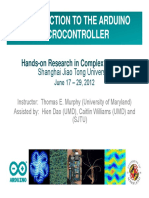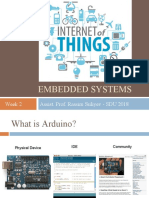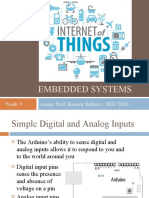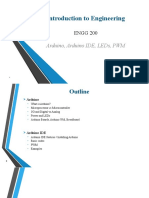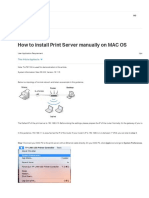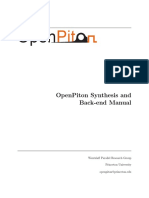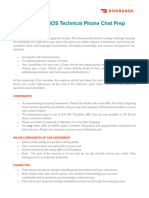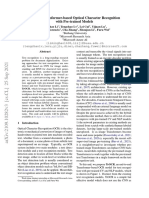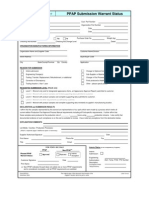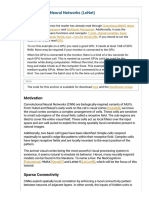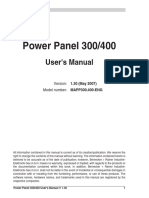Intro to the Arduino
Topics:
The Arduino
Digital IO
Analog IO
Serial Communication
�Topic 1: Meet Arduino Uno
�Getting Started
Check out: http://arduino.cc/en/Guide/HomePage
1. Download & install the Arduino environment (IDE)
(not needed in lab)
2. Connect the board to your computer via the USB
cable
3. If needed, install the drivers (not needed in lab)
4. Launch the Arduino IDE
5. Select your board
6. Select your serial port
7. Open the blink example
8. Upload the program
�Arduino IDE
See: http://arduino.cc/en/Guide/Environment for more info
�Select Serial Port and Board
�todbot.com/blog/bionicarduino
�Input/Output
Image from Theory and Practice of Tangible User Interfaces at UC Berkley
�Topic 2: Digital Input/Output
Digital IO is binary
valuedits either on
or off, 1 or 0
Internally, all
microprocessors are
digital, why?
�Arduino Digital I/0
www.mikroe.com/chapters/view/1
pinMode(pin, mode)
Sets pin to either INPUT or OUTPUT
digitalRead(pin)
Reads HIGH or LOW from a pin
digitalWrite(pin, value)
Writes HIGH or LOW to a pin
Electronic stuff
Output pins can provide 40 mA of current
Writing HIGH to an input pin installs a 20K
�Our First Program
�IO Pins
Image from Theory and Practice of Tangible User Interfaces at UC Berkley
�In-class Exercise 1: Digital IO
Use a push-button to turn ON/Off LED
�Topic 3: Analog Input
Think about music stored on a CD---an analog
signal captured on digital media
Sample rate
Word length
�Arduino Analog Input
Image credit: Tod Kurt
Resolution: the number of different voltage levels (i.e.,
states) used to discretize an input signal
Resolution values range from 256 states (8 bits) to
4,294,967,296 states (32 bits)
The Arduino uses 1024 states (10 bits)
Smallest measurable voltage change is 5V/1024 or 4.8 mV
Maximum sample rate is 10,000 times a second
�How does ADC work?
How does ADC work
Excel Demonstration
�Topic 3: Analog Output
Can a digital devise produce analog
output?
Image from Theory and Practice of Tangible User Interfaces at UC Berkley
Analog output can be simulated using
pulse width modulation (PWM)
�Pulse Width Modulation
Cant use digital pins
to directly supply say
2.5V, but can pulse
the output on and off
really fast to produce
the same effect
The on-off pulsing
happens so quickly,
the connected output
device sees the
result as a reduction
in the voltage
Image from Theory and Practice of Tangible User Interfaces at UC Berkley
�PWM Duty Cycle
output voltage = (on_time / cycle_time) * 5V
Image credit: Tod Kurt
Fixed cycle length; constant
number of cycles/sec
�PMW Pins
Command:
analogWrite(pin,value)
value is duty cycle:
between 0 and 255
Examples:
analogWrite(9, 128)
for a 50% duty cycle
analogWrite(11, 64)
for a 25% duty cycle
Image from Theory and Practice of Tangible User Interfaces at UC Berkley
�In-class Exercise 2: Analog IO
Part 1:
A light theremin
�In-class Exercise 2: Analog IO
Part 2: Add an LED
Add a 330 ohm resistor and an LED to
pin 9
Using the analogWrite() command,
set the intensity of the LED as a
function of the value of prReading
�Topic 4: Serial Communication
Image from http://www.ladyada.net/learn/arduino/lesson4.html
�todbot.com/blog/bionicarduino
�Serial Communication
Compiling turns your
program into binary data
(ones and zeros)
Uploading sends the bits
through USB cable to the
Arduino
The two LEDs near the USB
connector blink when data
is transmitted
RX blinks when the
Arduino is receiving data
TX blinks when the
todbot.com/blog/bionicarduino
�Open the Serial Monitor and
Upload the Program
�Some Commands
Serial.begin()
- e.g., Serial.begin(9600)
Serial.print() or Serial.println()
- e.g., Serial.print(value)
Serial.read()
Serial.available()
Serial.write()
Serial.parseInt()
Example Program
�Serial-to-USB chip---what does it do?
The LilyPad and Fio Arduino require an external USB to
TTY connector, such as an FTDI cable.
In the Arduino Leonardo a single microcontroller runs the
Arduino programs and handles the USB connection.
Image from Theory and Practice of Tangible User Interfaces at UC Berkley
�Two different communication
protocols
Serial (TTL):
Image from http://www.fiz-ix.com/2013/02/introduction-to-arduino-serial-communication/
�USB Protocol
Image from http://en.wikipedia.org/wiki/USB
Much more complicated
�In-class Exercise 3: Serial
Communication
Modify your program from in-class
exercise 2-part 2 to control the
intensity of the LED attached to pin 9
based on keyboard input.
Use the Serial.parseInt() method to
read numeric keyboard input as an
integer.
An input of 9 should produce full
intensity and an input of 0 should turn
the LED off.















